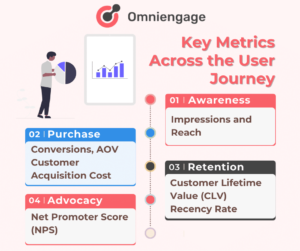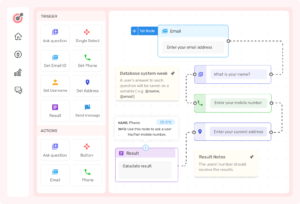Omnichannel marketing allows companies to reach potential customers across multiple touch-points and platforms. This makes creating an integrated experience for buyers easier. But how effective is your omni-channel campaign? And how can you assess its performance data to drive decisions that will help your company grow?
We’ll dive into the metrics of omnichannel marketing to provide a step-by-step guide on these analytics. This will measure outreach reception and customer engagement to make better-informed decisions regarding growth. So let’s get started!
A Unified View of Marketing
A unified view of your marketing is paramount in today’s digital world. It ensures that your efforts work synergistically to create a cohesive message. You can then reach the right audiences – such an approach brings various aspects of your marketing strategy closer.
A unified view lets you optimize your campaign performance by tracking data across different channels. This type of analysis helps to ensure that each component works seamlessly together. This gives a glimpse into how each facet performs and how they influence each other. The data can be used to refine and adjust your campaigns in real-time, helping you get the most out of them.
Another key benefit of having a unified view is that it gives you access to segmentation aspects. You can identify target audiences by focusing on user segmentation. A segment like demographics has different factors – age, gender, and income level. With newer digital marketing strategies, personalization has become possible. Instead of sending a generic email to all their customers, they can categorize their audience into segments based on factors such as past purchases or expressed interest. This enables marketers to effectively engage with their audience, deliver more relevant messages, and achieve better results in their marketing efforts.
Customer Data Processing: Key Points and Benefits of Omnichannel Marketing
CDP organizes and analyzes customer data to provide insights into their behaviour. It utilizes data-driven technology for specialized software applications to collect, store, organize, and analyze this data. It aims to understand better – customers’ needs, wants, and behaviours. This allows them to improve marketing initiatives and customer experiences.
Collecting accurate and timely information is critical. It helps to store this information securely or to organize the data for easy access. You can analyze the data for trends or patterns and create reports to summarize analysis results. Next, you can develop strategies based on what the analysis reveals.
Customer Data Processing – CDP is used for segmenting customers into different target markets or creating personalized content.
CDP benefits are vast, ranging from improved marketing effectiveness to increased revenue. Access to accurate, up-to-date customer information allows businesses to make more informed decisions. This helps them to target their campaigns better. Or customize their products or services to meet consumer needs.
Companies can design targeted experiences through an extensive analysis of customer preferences. They can ensure that it appeals to relevant customer segments. For example, increasing sales revenue and improving brand loyalty.
Enhancing the Customer Experience: Omnichannel Marketing Analytics
Omnichannel reporting and analytics are indispensable in enhancing the customer experience. Combining data from multiple channels allows businesses to understand how customers interact with their brands. This data can be used to identify patterns in customer behaviour. It helps develop segmentation strategies for targeted marketing campaigns and increase customer engagement. By examining customer interactions across multiple channels, organizations can better
#1 Understand how customers use each platform to discover products and services, evaluate them, make purchases, and resolve these issues.
This data creates a global picture of the customer journey. It can be used to further optimize every step along the way. For instance, if a business sees many potential customers abandon their shopping carts due to slow page loading times, they can resolve this issue. As a result, customers have a better experience using the service on any device.
#2 Track marketing metrics, such as campaign ROI or overall website performance.
This data can be used to adjust strategies and create more effective campaigns to drive sales. For example, a company notices that many of its leads come from organic search engine results pages (SERPs). In that case, they may focus more resources on optimizing their website for SEO. This way, you can get even more organic traffic in the future.
Omnichannel reporting is a critical resource for understanding customer behaviour. Analytics from these reports provide data on activities across different channels. With these tools, businesses acquire valuable insights about customer interactions. These insights help them deliver better services and drive higher customer satisfaction in the long run.
KPIs Across the Different Stages of the Customer Journey
The five stages of the customer journey are awareness, purchase, retention, advocacy and finally, repurchase. At each stage of the customer journey, it is essential to measure specific metrics to ensure success.
Awareness Stage, you should measure impressions and reach to understand how many people engage with your brand.
Purchase Stage, measuring conversions and average order value, is vital to gauge whether customers are making purchases. Measuring growth is essential at this stage, such as customer acquisition cost. This indicates how much money is spent to acquire or retain new customers.

Retention Stage, here, the key metrics include customer lifetime value (LTV) and recency/repurchase rate. This indicates if customers return after making a one-time purchase or buying from your store regularly.
Advocacy Phase, measuring customer satisfaction through a Net Promoter Score (NPS) survey is essential. NPS provide insights into how likely customers are to recommend products or services from your store to other.
Businesses can gain valuable insights into their customer base by measuring these critical metrics. When you have the data across the five customer journey stages, you can help them optimize their marketing efforts. You can ensure that sales increase over time.
Conclusion
Having a unified view of your marketing is essential. A broad understanding of your company’s performance in the marketplace can help you make strategic decisions. This will lead to higher ROI and more successful campaigns. In addition, a unified view allows you to keep track of key performance indicators (KPIs) across all channels.
The measure of effectiveness against goals and compare performance from one channel to another. This helps to identify areas for potential improvement and allocate resources. The omnichannel reporting and analytics, allow tracking metrics at key customer journey stages for your brand to maximize their success. Companies can better understand their customers and build a personalized experience. One can have more loyal customers. They are more likely to purchase from them. Sign-Up Free for a 7-Day Free Trial of OmniEngage.







